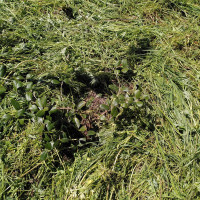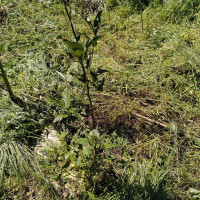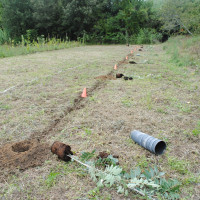Syntropic 3: Carya illinoinenis
Pecan tree planting
Pecan tree plantation, 6m spacing.
The design tests planting larger cuttings of poplar and mulberry in the fall, to grow as much root as possible for the followiing summer and be ready to pollard for biomass. If any cutting dries out, it can be easily replaced early March.
The entire center-line is a seedbed for annual/biennual species. Deep-rooted plants will promote decompaction and help improve subsoil water capacity. The evergreens will provide insect shelter and wind-break during winter time. Thistles may provide some protection to other plants while being of service to pollinators. The quick cover will provide shade for future crop cuttings or seeds to establish; the minimal management is pruning for light.
Biennual/Perennial seeds: Fragaria vesca, Dittrichia viscosa, Foeniculum vulgare, Salvia sclarea, Origanum vulgare, Allium schoenoprasum
Annual seeds: Melilotus alba, M. officinalis, Carthamus tinctorius, Cirsium vulgare, Verbascum thapsus, Cynara scolumus
Crop cuttings: Pomegranate and fig cuttings may provide extra crop until shaded out by the pecans. Nisper and feijoa may become the understory crop of choice.
Colutea arborescens and Vitex agnus-castus are also being tried as cuttings, if they succeed they will become stock for further plantings.
Main line
| Species variety | Var | Leafing | Flowering | Fruiting | ||||||||||||||||||||||||||||||||||||
|---|---|---|---|---|---|---|---|---|---|---|---|---|---|---|---|---|---|---|---|---|---|---|---|---|---|---|---|---|---|---|---|---|---|---|---|---|---|---|---|---|
Eriobotrya japonica |
|
|
| |||||||||||||||||||||||||||||||||||||
Carya illinoinensis Osage | Osage Pollinator variety |
|
|
| ||||||||||||||||||||||||||||||||||||
Carya illinoinensis Pawnee | Pawnee * |
|
|
| ||||||||||||||||||||||||||||||||||||
Carya illinoinensis Wichita | Wichita * |
|
|
| ||||||||||||||||||||||||||||||||||||
Melilotus albus |
|
|
| |||||||||||||||||||||||||||||||||||||
Morus alba Kokuso | Kokuso Semi-dwarf, seedless, cold-resistant. can be propagated with cuttings |
|
|
| ||||||||||||||||||||||||||||||||||||
Populus nigra Hybrid | Hybrid Commonly used for wood production. |
|
|
| ||||||||||||||||||||||||||||||||||||
Acca/feijoa sellowiana Mammoth | Mammoth Selected in New Zealand from seedlings of the Choiceana. Large, round to oval fruit, to 8-1/2 ounces, resembling Coolidge. Skin thick, somewhat wrinkled. Flesh somewhat gritty, quality and flavor very good. Matures early in midseason. Softer and not as good a shipper as Triumph. Tree of upright habit, to 10 ft. tall, strong growing. Self-fertile, but bears larger fruit, with cross-pollination. |
|
|
| ||||||||||||||||||||||||||||||||||||
Acca/feijoa sellowiana Triumph | Triumph Selected in New Zealand from seedlings of the Choiceana cultivar. Short, oval, plump fruits., not pointed as those of Coolidge, medium to large. Skin uneven but firm. Flesh somewhat gritty but with good seed to pulp ratio. Excellent sharp flavor. Ripens to midseason. Tree upright, of medium vigor. Bears heavily if pollinated. Good pollinator for Mammoth. |
|
|
| ||||||||||||||||||||||||||||||||||||
Elaeagnus umbellata Amoroso | Amoroso The autumn oleaster Pointilla® 'Amoroso®' grows as a somewhat sparse large shrub and can reach a height of up to 4 m. With regular pruning, however, Pointilla® 'Amoroso®' can be kept well below 3 m in height. As with all fruit bushes, the autumn willow tree - Eleaeagnus umbellata - should be regularly rejuvenated. In the case of Pointilla® 'Amoroso®' this means that every few years the oldest main shoots should be removed. Pointilla® 'Amoroso®' only has medium-sized fruits in comparison, but a lot of them and in terms of taste Pointilla® 'Amoroso®' is the best variety with a fine aroma and no astringency. |
|
|
| ||||||||||||||||||||||||||||||||||||
Elaeagnus umbellata Fortunella | Fortunella ? |
|
|
| ||||||||||||||||||||||||||||||||||||
Elaeagnus umbellata Sweet’n’sour | Sweet’n’sour ? |
|
|
|
| Species variety | Tip | Qty | Introduction | Phase-out | Propagation | Medium | Supplier |
|---|---|---|---|---|---|---|---|
Eriobotrya japonica | |||||||
Carya illinoinensis Osage | Trees grown from seed (pre-germination recommended) are more liikely to survive non-irrigated plantations, as they form a deeper root system and better ratio between aerial and root volumes. At large scale this reduces costs and risk. [youtu.be] Manure + crop harvest can result in E. coli. This applies especially if harvesting crop on the ground, but hand harvesting also requires hygiene. | 1 | 2023-09-02 | Graft | Container | Fruitex | |
Carya illinoinensis Pawnee | Trees grown from seed (pre-germination recommended) are more liikely to survive non-irrigated plantations, as they form a deeper root system and better ratio between aerial and root volumes. At large scale this reduces costs and risk. [youtu.be] Manure + crop harvest can result in E. coli. This applies especially if harvesting crop on the ground, but hand harvesting also requires hygiene. | 3 | 2023-09-02 | Graft | Container | Fruitex | |
Carya illinoinensis Wichita | Trees grown from seed (pre-germination recommended) are more liikely to survive non-irrigated plantations, as they form a deeper root system and better ratio between aerial and root volumes. At large scale this reduces costs and risk. [youtu.be] Manure + crop harvest can result in E. coli. This applies especially if harvesting crop on the ground, but hand harvesting also requires hygiene. | 3 | 2023-09-02 | Graft | Container | Fruitex | |
Melilotus albus | 2023-09-15 | Seed | Seed | El Meandre | |||
Morus alba Kokuso | Propagation with cuttings, take in January, roots in 1 month. [Plant supplier / nursery] Morus alba makes superficial roots from cuttings, but deep roots from seed. Micropropagation root structure similar to seed. [Plant supplier / nursery] Thorny branches can help protect seedlings from boars or deer. Having a diversity of support species can reduce the animal's focus on the cash crop. Mulberry cuttings need good aeration to root properly, if medium is heavy clay soils, mix sand or material to improve aeration. | 6 | 2023-09-02 | Stem cutting | Cutting | Mas des Manhans | |
Populus nigra Hybrid | Populus and Salix cutting propogation: Las estacas de Populus y Salix hay que prepararlas cuando no tienen hojas, a sabia parada. Igualmente, el brote que te puedan hacer ahora no estará lignificado y con el frío del invierno se puede quemar. Estas estacas enraizaran y brotaran en primavera, por lo que en invierno poco van a hacer. [Plant supplier / nursery] Q__ La estaca de Populus/Salix, tiene que ser del año de crecimiento o puede ser de 2/3 años? Puede ser de 2/3 años. A__ Nosotros lo hacemos en alveolo forestal, por lo que utilizamos estacas delgadas, del año, pero en campo es conveniente ponerlas más gordas para que tengan más reservas y aguanten el terreno. Q__ Y se puede enterrar/clavar la estaca muy profundo, como 40-50cm o más? Se puede pudrir? A__Sí, se puede pudrir, sobretodo si hay agua estancada durante muchos días. Yo intentaría clavarlas en febrero para que estén el menor tiempo enterradas y sin brotar. [Plant supplier / nursery][naturalea.eu] Poplar's high water content can cause Frost crack when too cold. Can hybrid poplars have less or more resistance? Thorny branches can help protect seedlings from boars or deer. Having a diversity of support species can reduce the animal's focus on the cash crop. Trees with fibrous root structures (poplars, acacias, oaks) are able to improve soil though growth and dieback every year, not the case with every species. Is this related to the tree being deciduous or its ability to re-grow after pruning? [youtu.be] Cuttings directly on the ground need a wide area clearing and weed suppression, use large leaves and heavy thick mulch. [Can Neret] Deer likes young poplar leaves. Use very long cuttings to reduce risk. [Can Neret] Hybrid poplars grow much, much faster without weed competition. Plantings are made on bare ground and disced 4 times a year on the first year for this reason. Management is no longer required when undergrowth is shaded after 2nd year. [lignovis.com] | 12 | 2023-09-02 | Stem cutting | Cutting | Can Neret | |
Acca/feijoa sellowiana Mammoth | Propagates cultivars by cuttings. [Plant supplier / nursery] | 1 | 2023-11-13 | Stem cutting | Container | Lurberry | |
Acca/feijoa sellowiana Triumph | Propagates cultivars by cuttings. [Plant supplier / nursery] | 1 | 2023-11-13 | Stem cutting | Container | Lurberry | |
Elaeagnus umbellata Amoroso | 1 | 2023-11-13 | Stem cutting | Container | Lurberry | ||
Elaeagnus umbellata Fortunella | 1 | 2023-11-13 | Stem cutting | Container | Lurberry | ||
Elaeagnus umbellata Sweet’n’sour | 1 | 2023-11-13 | Stem cutting | Container | Lurberry |
| Species variety | Fnc | Strata | Top | Cut months | Light | Functions | |
|---|---|---|---|---|---|---|---|
Eriobotrya japonica | 5m | >75% | |||||
Carya illinoinensis Osage | Emergent | 8m | ~50% | ||||
Carya illinoinensis Pawnee | Emergent | 8m | ~50% | ||||
Carya illinoinensis Wichita | Emergent | 8m | ~50% | ||||
Melilotus albus | Emergent | 2.5m | <25% | Crop shading, Pioneering N | |||
Morus alba Kokuso | Canopy | 18m | >75% | ||||
Populus nigra Hybrid | Canopy | 4m | Pollard [5] | ~50% | |||
Acca/feijoa sellowiana Mammoth | Understory | 3m | ~50% | ||||
Acca/feijoa sellowiana Triumph | Understory | 3m | ~50% | ||||
Elaeagnus umbellata Amoroso | Understory | 4.5m | ~50% | N | |||
Elaeagnus umbellata Fortunella | Understory | 4.5m | ~50% | N | |||
Elaeagnus umbellata Sweet’n’sour | Understory | 4.5m | ~50% | N |
Project Log
2024 week 16 20/5°C, 3.2mm
2024 week 15 24/7°C, 9.3mm
2024 week 14 23/7°C, 0mm
2024 week 13 19/8°C, 36.8mm
2024 week 12 22/9°C, 0mm
Time is lost looking for small plants to manage (small poplar cutting). Larger poplar replacements well established.
2024 week 10 17/2°C, 5.5mm
2024 week 09 17/3°C, 33.3mm
2024 week 08 18/3°C, 3.3mm
2024 week 07 20/4°C, 0mm
2024 week 06 18/5°C, 18.5mm
50% of hybrid poplar cuttings planted in September still alive. Others replaced. Flipped stones and seeded Physalis peruviana on exposed bare ground.
2023 week 51 19/-3°C, 0mm
2023 week 50 17/4°C, 0mm
2023 week 49 15/3°C, 6.9mm
2023 week 48 17/5°C, 2.3mm
2023 week 47 19/2°C, 2.6mm
Girdling from wire-tie detected and removed. Check when buying plants in nursery
2023 week 40 28/14°C, 0.1mm
2023 week 39 30/13°C, 0mm
2023 week 38 27/14°C, 6.7mm
2023 week 37 30/16°C, 36.8mm
2023 week 36 32/13°C, 0mm
Cuttings 1 month after planting. The 25cm diameter stones can be flipped over in the fall, exposing bare and moist soil ready for seeding.
2023 week 35 28/14°C, 0.8mm
2023 week 34 36/20°C, 26.8mm
2023 week 33 36/17°C, 0mm
2023 week 32 33/18°C, 0.5mm
2023 week 31 31/16°C, 2mm
Drilled holes for Pecan seedlings, and large poplar & mulberry cuttings. Poplars are fully lignified, planted 50cm below and 2m above surface. Mulberry 50cm below, 1m above.
Lessons
- Can Neret
Plant supplier / nursery[Design] Rocks can retain water underneath, and be used as a place-holder of bare ground for future seeds. When flipped over at seeding time, it can shelter the seedling from wind, provide afternoon shade, or be a thermal mass. - Can Neret
Plant supplier / nursery[Design] Perennial plants provide stability / shelter for insects during winter, and slow down wind reducing water loss. - Plant supplier / nursery
[Seed /Stem cutting] Morus alba makes superficial roots from cuttings, but deep roots from seed. Micropropagation root structure similar to seed.(Morus alba) - Nursery seedlings can be girdled by wire-ties on support stakes. Check, and remove where risk exists.Can Neret




























